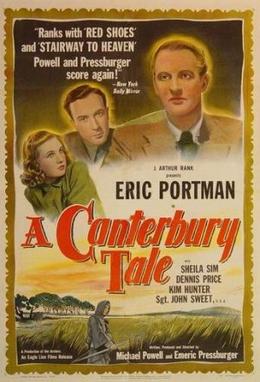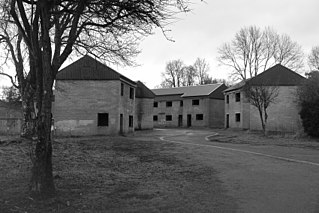
A Canterbury Tale is a 1944 British film by Michael Powell and Emeric Pressburger starring Eric Portman, Sheila Sim, Dennis Price and Sgt. John Sweet; Esmond Knight provided narration and played two small roles. For the post-war American release, Raymond Massey narrated and Kim Hunter was added to the film. The film was made in black and white, and was the first of two collaborations between Powell and Pressburger and cinematographer Erwin Hillier.

Michael David Wood, is an English historian and broadcaster. He has presented numerous well-known television documentary series from the late 1970s to the present day. Wood has also written a number of books on English history, including In Search of the Dark Ages, The Domesday Quest, The Story of England, and In Search of Shakespeare. He was appointed Professor of Public History at the University of Manchester in 2013.

Carenza Rachel Lewis is a British academic archaeologist and television presenter.

Tintagel Castle is a medieval fortification located on the peninsula of Tintagel Island adjacent to the village of Tintagel (Trevena), North Cornwall in the United Kingdom. The site was possibly occupied in the Romano-British period, as an array of artefacts dating from this period have been found on the peninsula, but as yet no Roman-era structure has been proven to have existed there. It was settled during the early medieval period, when it was probably one of the seasonal residences of the regional king of Dumnonia. A castle was built on the site by Richard, 1st Earl of Cornwall in the 13th century, during the High Middle Ages. It later fell into disrepair and ruin.

Eyam is an English village and civil parish in the Derbyshire Dales that lies within the Peak District National Park. There is evidence of early occupation by Ancient Britons on the surrounding moors and lead was mined in the area by the Romans. A settlement was founded on the present site by Anglo-Saxons, when mining was continued and other industries later developed. However, Eyam’s main claim to fame is the story of how the village chose to go into isolation so as to prevent infection spreading after bubonic plague was discovered there in 1665.

Oakley is a village and civil parish in Buckinghamshire, England. It has an area of 2,206 acres (893 ha) and includes about 400 households. The 2011 Census recorded the population as 1,007.

Oadby is a town in the borough of Oadby and Wigston in Leicestershire, England. Oadby is a district centre 4 miles (6.4 km) south-east of Leicester on the A6 road. Leicester Racecourse is situated on the border between Oadby and Stoneygate. The University of Leicester Botanical Garden is in Oadby. Oadby had a population of 23,849 in 2011, and like its neighbour Wigston is made up of five wards. The Borough of Oadby and Wigston is twinned with Maromme in France, and Norderstedt in Germany.
Malham is a village and civil parish in the Craven district of North Yorkshire, England. Before 20th century boundary changes, the village was part of the Settle Rural District, in the historic West Riding of Yorkshire. In the Domesday Book, the name is given as Malgun, meaning "settlement by the gravelly places". In 2001 the parish had a population of approximately 150. Malham parish increased in size geographically and so at the 2011 Census had a population of 238.

Kibworth is an area of the Harborough district of Leicestershire, England, that contains two civil parishes: the villages of Kibworth Beauchamp and Kibworth Harcourt. At the 2011 census, Kibworth Beauchamp had a population of 5,433 and Kibworth Harcourt 990. The villages are divided by the Midland Main Line. Kibworth is close to Foxton Locks, Market Harborough, and Leicester.

Milverton is a village and civil parish in Somerset, England, situated in the valley of the River Tone 5 miles (8.0 km) west of Taunton. The village has a population of 1,438. The parish includes the hamlet of Preston Bowyer.

Imber is an uninhabited village and former civil parish within the British Army's training area, now in the parish of Heytesbury, on Salisbury Plain, Wiltshire, England. It lies in an isolated area of the Plain, about 2+1⁄2 miles (4 km) west of the A360 road between Tilshead and West Lavington. A linear village, its main street follows the course of a stream.

Long Melford, colloquially and historically also referred to as Melford, is a large village and civil parish in the Babergh district, in the county of Suffolk, England. It is on Suffolk's border with Essex, which is marked by the River Stour, 3 miles (4.8 km) from Sudbury, approximately 16 miles (26 km) from Colchester and 14 miles (23 km) from Bury St Edmunds. It is one of Suffolk's "wool towns" and is a former market town. The parish also includes the hamlets of Bridge Street and Cuckoo Tye.

Copthorne is a village in the Mid Sussex district of West Sussex, England. It lies close to Gatwick Airport, 25.5 miles (41 km) south of London, 21.5 miles (35 km) north of Brighton, and 36 miles (58 km) northeast of the county town of Chichester. Nearby towns include Crawley to the southwest and East Grinstead to the east. It is the most northerly ecclesiastical parish in the Diocese of Chichester in the Church of England, and together with Crawley Down makes up the civil parish of Worth.

Northchapel is a village and civil parish in Chichester District in West Sussex, England. It stands on the A283 road just south of the Surrey border, around 9 km north of Petworth.

Llangwm is a small village, parish and community of around 450 properties situated on the Llangwm Pill off the River Cleddau estuary near Haverfordwest, Pembrokeshire, Wales. It has a history of mining and fishing and is in the largely English-speaking south of the county.

The Story of India is a BBC documentary series, written and presented by historian Michael Wood about the history of India. It originally aired on BBC Two in six episodes in August and September 2007 as part of the BBC season "India and Pakistan 07", which marked the 60 year independence of India and Pakistan. An accompanying text to the series, titled Michael Wood: The Story of India, was published by BBC Books on 16 August 2007.

Grovely Wood is one of the largest woodlands in southern Wiltshire, England. It stands on a chalk ridge above the River Wylye in Barford St Martin parish, to the south-west of the village of Great Wishford, within the Cranborne Chase and West Wiltshire Downs Area of Outstanding Natural Beauty. It is recognised for its nature conservation importance through designation as a County Wildlife Site. Among the species found here is the Purple Emperor butterfly.

In Search of the Trojan War is a six-part BBC TV documentary series written and presented by Michael Wood, first broadcast in 1985 on BBC2. It examines the extent to which historical and archeological evidence matches the tale of the Trojan War as recounted by Homer in The Iliad.

Lucy Worsley is a British historian, author, curator and television presenter. She is joint chief curator at Historic Royal Palaces but is best known as a presenter of BBC Television and Channel 5 series on historical topics.

The Great British Story: A People's History is a 2012 documentary in eight parts written and presented by Michael Wood looking at history through the eyes of ordinary people airing on the BBC.



















